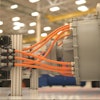3D Hubs releases its quarterly report that shows real world data on which CNC materials and surface finishes are requested the most by engineers globally.
Every quarter 3D Hubs releases the Digital Manufacturing Trends; a report that summarizes all real-world data collected from a global network of 6,000 manufacturing services, who produce more than 200,000 parts are produced quarterly. It is the only report in the manufacturing industry that is based on hard numbers, providing the most extensive overview of the latest trends in technologies such as 3D printing, CNC machining and more.
Here’s some of the latest insights (from Q2/2018) regarding the most requested materials and surface finishes for CNC machining.
Q2 marks the halfway point of 2018. Spring is always a busy time for manufacturing and prototyping: engineers begin new projects after the end of the financial year and students are preparing their final year projects.
The Most Popular CNC Materials
Almost every material with sufficient hardness can be CNC machined. The most common examples include metals,such as aluminum and steel alloys, brass, or plastics (such as ABS, Delrin, Nylon etc).
In Q2, 19 new materials were introduced to 3D Hubs which had a big impact on the Top 10 most requested materials.
Aluminum 6061 is an aerospace grade material but also the most affordable material for CNC machining as is it easy-to-machine. In Q2, it was by far the most requested material but its market share was decreased marginally by 2.3 percent compared to Q1 as more material options became available on the platform. Even with this decrease, however, it still keeps the lion’s share with more than 50 percent of the machining being done with Al 6061.
Stainless Steel 304 is at #2, but saw the biggest drop in popularity in Q2, dropping from 11.6 percent in the previous quarter to 6.8 percent now. This is partly explained by the introduction of Stainless Steel 316 (at #9 with 2.6 percent), which has similar mechanical properties but higher corrosion and chemical resistance, making it more suitable for applications in harsh environments. The introduction of Mild Steel 1018 (at #4 with 5.0 percent) further impacted the popularity of SS 304, as it is a more economical option with similar mechanical properties.
Looking at plastic, Delrin - also known as POM or Acetal - was the most popular option (at #3 with 5.0 percent of market share). Delrin is the easiest-to-machine plastic and has high stiffness with good frictional characteristics, making it more attractive than the alternatives of ABS (at #8 with 3.2 percent) and Polycarbonate (at #10 with 2.0 percent).
The Most Requested Surface Finishes
Surface finishes are applied after machining and can affect the function or aesthetics of a machined part. Selecting the right surface finish is sometimes as important as choosing the right material, since it affects a part’s appearance, surface roughness, hardness and chemical resistance of the produced parts.
With the introduction of new materials to the platform, the requested surface finishes also became more diverse.
The As-machined surface finish was by far the most requested as it provides the tightest dimensional tolerances and comes at no extra cost, but it dropped slighted since Q1 in popularity 7 percent to 70.8 percent.
Bead blasting at #2 is still a long way off though at #2 with 7.5 percent, but it is still popular as it provides visually pleasing matte or satin finish at a relatively low cost.
Anodizing at its various forms (colored, clear or hardcoat) was requested approximately in 9.3 percent of all orders, which is not a surprise as aluminum is by far the most used material and anodizing is a common finish for it. Colored anodizing was much more popular than clear (probably due to aesthetic reasons) and that hardcoat anodizing as the latter is a high wear resistance coating for top-end engineering applications.
More materials also bring requests of more varied and less traditional finishing techniques. An example of this would be chromate conversion coating used heavily by the aerospace industry.
Find out more industry data in the Digital Manufacturing Trends here including:
- The highest rated industrial and desktop 3D printers based on customer reviews
- The most widely used manufacturing technologies and materials
- The most popular CNC materials and finishes being used in industry
- The popularity of manufacturers and printer models
- The top cities and countries doing the most 3D printing
Alkaios Bournias Varotsis, PhD is a technical marketing engineer at 3D Hubs.























